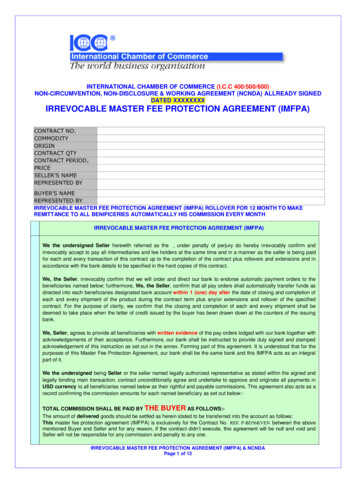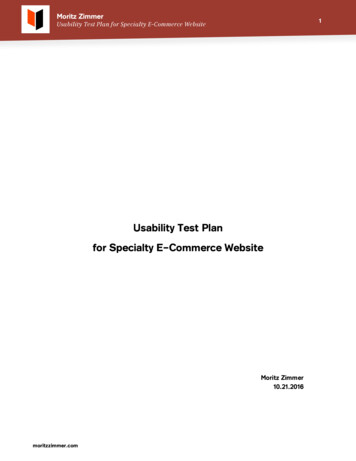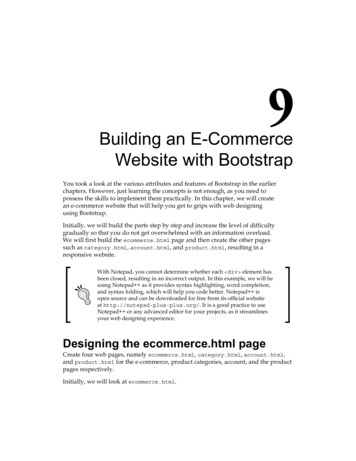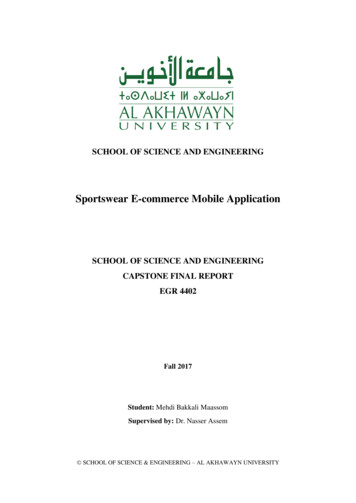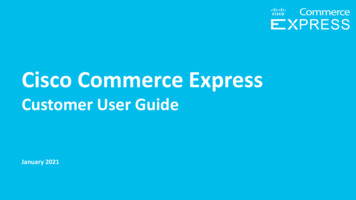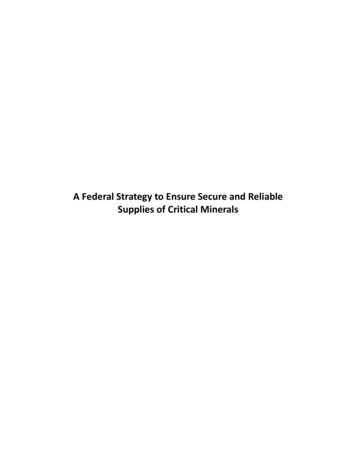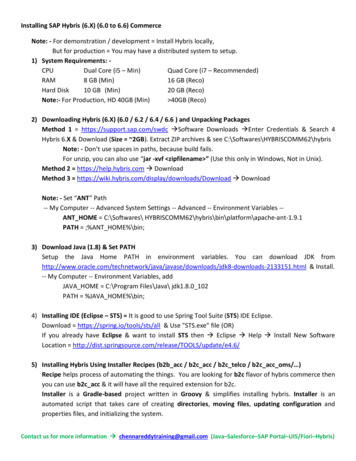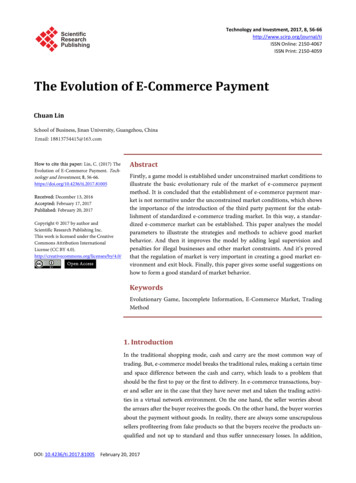
Transcription
Technology and Investment, 2017, 8, 56-66http://www.scirp.org/journal/tiISSN Online: 2150-4067ISSN Print: 2150-4059The Evolution of E-Commerce PaymentChuan LinSchool of Business, Jinan University, Guangzhou, ChinaHow to cite this paper: Lin, C. (2017) TheEvolution of E-Commerce Payment. Technology and Investment, 8, d: December 13, 2016Accepted: February 17, 2017Published: February 20, 2017Copyright 2017 by author andScientific Research Publishing Inc.This work is licensed under the CreativeCommons Attribution InternationalLicense (CC BY en AccessAbstractFirstly, a game model is established under unconstrained market conditions toillustrate the basic evolutionary rule of the market of e-commerce paymentmethod. It is concluded that the establishment of e-commerce payment market is not normative under the unconstrained market conditions, which showsthe importance of the introduction of the third party payment for the establishment of standardized e-commerce trading market. In this way, a standardized e-commerce market can be established. This paper analyses the modelparameters to illustrate the strategies and methods to achieve good marketbehavior. And then it improves the model by adding legal supervision andpenalties for illegal businesses and other market constraints. And it’s provedthat the regulation of market is very important in creating a good market environment and exit block. Finally, this paper gives some useful suggestions onhow to form a good standard of market behavior.KeywordsEvolutionary Game, Incomplete Information, E-Commerce Market, TradingMethod1. IntroductionIn the traditional shopping mode, cash and carry are the most common way oftrading. But, e-commerce model breaks the traditional rules, making a certain timeand space difference between the cash and carry, which leads to a problem thatshould be the first to pay or the first to delivery. In e-commerce transactions, buyer and seller are in the case that they have never met and taken the trading activities in a virtual network environment. On the one hand, the seller worries aboutthe arrears after the buyer receives the goods. On the other hand, the buyer worriesabout the payment without goods. In reality, there are always some unscrupuloussellers profiteering from fake products so that the buyers receive the products unqualified and not up to standard and thus suffer unnecessary losses. In addition,DOI: 10.4236/ti.2017.81005February 20, 2017
C. Lindue to the incomplete information in the e-commerce market, the buyer can’t determine the satisfactory sellers. They can only guess the general situation of themarket after each shopping experience and modify their behavioral strategies toimprove the shopping effectiveness. Under these circumstances, incomplete information may affect the seller’s and the buyer’s choice of behavioral strategies,causing market ultimately evolved and locked to bad situation. JY Wang, LM Cao(2008) [1] established a dynamic game model of imperfect information, and set thegame income matrix. The paper used the Nash equilibrium to calculate the transaction results, and found that the third- party trading platform was conducive tothe further improvement of the market. Liu B (2009) [2] established an evolutionary game model to the limited rational C2C E-commerce sellers’ trade tactic selection. According to discussing the relationship of the model’s parameters, heanalyzed the long-term evolutionary trend of both good-credit and bad-credit C2CE-commerce sellers’ tactic selection under different conditions. Jun Wang (2009)[3] conducted a signal game to analyze the credit problems frequently happeningin e-commerce. And some strategies have been put forward to promote the integrity between the buyer and seller. Yi Y (2003) [4] established an evolutionary gamemodel that was constructed to study the basic evolution law of the credit marketwith no restriction. How to reach good market behavior is illustrated by analyzingand controlling model parameters. This paper introduces the regulation of themarket to show how to make the normative e-commerce market come into being.G Jiang (2006) [5] establishes a model of evolutionary game theory in the condition of unconstrained market to illustrate the basic evolutionary law of consultingmarket according to the developing process of Chinese consulting market in hydropower project construction.With the continuous development of e-commerce, e-commerce at this stage of thepayment methods includes the following: payment gateway model; online bankingmodel; third-party payment model; mobile payment model; cash on delivery.After the research of Bo L (2006) [6] and so on, through the payment gatewayand online banking to pay faster way, the customer’s money can be transferredto the merchant’s account in real time, greatly speeding up the turnover rate offunds; on the other hand, the payment process data encryption and other measures to a certain extent ensure the security of the payment.Mobile payment is a new type of payment recently appeared, because it usesthe convenience and popularity of mobile phones, and the market is very optimistic about the prospects. With the third party payment, the customers don’thave to pay to the seller directly, and have the right to withdraw the payment iffinding something wrong in the products, so as to avoid losses. This paymentmethod is easy to be accepted and is currently the most commonly used payment. While the Cash on delivery has a certain application currently, it hashigher requirement of trust online.Because the-commerce in China has been in growth period, both the incomplete information and nonstandard behavior are unavoidable in e-commercemarket. So the paper that tries to form standard rules of e-commerce market and57
C. Linmake the market in inefficient state so as to withdraw from the lock could bevery meaningful.2. Establishment and Analysis of ModelAssume that in a “natural” (without regard to other constraints) market, the sellers and buyers trade strategically. It’s supposed that considering the benefit, thebuyers tend to pay for the goods after the delivery firstly, but during the negotiation with the sellers, they could insist cash on delivery (We call this choice B1),or not (B2). At the same time, assume that the seller will prefer to receive thepayment first. But in the actual negotiations with the buyer the sellers will havetwo kinds of behaviors: insist on payment after delivery (S1) and do not insist onpayment after delivery (S2).Assume that without other constraints, the buyer and seller are like to breakthe rules of transaction, if there happens delivery without payment or paymentwithout delivery. Because from the aspect of interests, it is profitable of receivingthe payment without delivery or receiving the goods without paying. Assumethat: 1) If B1 and S1 happen at the same time, deal can’t work. 2) If B1 and S2happen at the same time, because of the buyer’s strong negotiation ability, therewill come to an agreement of cash on delivery. 3) If B2 and S1 happen at thesame time, there will form an agreement of cash before delivery due to seller’sstrong negotiation ability. 4) If B2 and S2 happen at the same time, the buyerand seller’s negotiation ability is equal. So, the agreement of cash on delivery isas possible as the agreement of cash before delivery (Table 1).In the table, C1 stands for the loss caused by the failure of the seller, C2presents the loss caused by the failure of the buyer; GD 0 means the utility surplus of the buyer which equals the total utility minus the commodity price paid;GP 0 represents the seller’s profit after selling the goods (total revenue minusthe total cost); E 0 means the extra profits that caused by sellers’ receiving thepayment without delivery or by buyers’ receiving the goods without payment.Assume that the proportion of buyers taking strategy B1 in the buyer group is p.And the proportion of sellers who adopt strategy S1 in the seller group is q. According to the Malthusian dynamic equation and the rule that the growth rate ofthe strategy is equal to its relative fitness, it means that as long as the Individualadopting the strategy has higher fitness than the average, the strategy grows. Thekinetic equation is expressed asp p e A Q P A Q(1)q p e B Q P B QIn the equation, e {1, 0} is the unit vector, and p {p, 1 p} is the hybridstrategy of B1 and B2. Q {q, 1-q} is the mixed strategy of S1 and S2. A and BTable 1. The payment matrix for the seller and buyer.buyerB1B258sellerS1 C2, C1GD E, GP ES2GD E, GP EGD, GP
C. Linrepresent the payment matrix for buyers and sellers, respectively. Then e A Qand P A Q denotes the fitness of the buyer adopting strategy B1 and the average fitness of the buyer group, respectively. And e B Q and P B Qrepresents the fitness of the seller adopting the strategy S1 and the average fitness of the seller, respectively. So the dynamic equation of the e-commerce payment market can be drawnp p (1 p ) E ( C2 GD ) q q q (1 q ) E ( C1 GP ) p (2)Proposition 1: If C1 GP E and C2 GD E, system (2) shows that on theplane M {(p, q); 0 p, q 1}, there are five equilibrium points of the evolutionary game between the buyer and the seller, which are unstable points (0, 0), (1,1) and stable points (0, 1), (1, 0) and saddle points F ( E C1 GP , E C2 GD ) .Proof: Consider C1 GP E and C2 GD E only.Because if C1 GP E and C2 GD E, at least one of p or q is con-stantly greater than zero. If p increases from 0 to 1, it means that the buyer willinsist on cash on delivery otherwise withdraw from the market, making themarket instable. And if q increases from 0 to 1 monotonously, the seller will insist on cash before delivery, otherwise the seller will withdraw from the market,making the market instable too. It’s also possible that p and q increase from 0 to1 at the same time. The buyer insists on cash on delivery and the seller insists oncash before delivery, in which the market can’t be formed.When C1 GP E and C2 GD E, it is obvious that there are five equilibrium points in system (2), which are (0, 0) (1, 1) (0, 1) (1, 0) and F. With theanalysis on them, we can see that (0, 0) and (1, 1) are instable source points, (0,1), (1, 0) are stable import points and F is the saddle point. The phase diagram ofthe system (2) that is given by Proposition 1 is shown in Figure 1.The analysis of Figure 1 shows that the system converges at (0, 1) when theinitial state is in the upper left region (called region G) of the line in which thepoint (0, 0), point (1, 1) and point F. It means that all the sellers insist on cashFigure 1. Evolution rule of e-commerce without constraints.59
C. Linbefore delivery, and the buyers do not insist on cash on delivery. When the initial state is in the bottom right region (called region H) of the line in which thepoint (0, 0), point (1, 1) and point F, the system will converges at (1, 0). That isto say all the buyers insist on cash on delivery and the sellers do not insist oncash before delivery.It’s found that the long time evolution of e-ecommerce would be completelydifferent and not normative only with buyer and seller in the market. Both thetwo state that the sellers don’t deliver the goods after the buyers’ payment andthat the buyers don’t pay for the goods after the sellers’ delivery are evolved stable. In either state, the participant taking the other behavior strategy would bechosen to leave by the market.The reason why the normative market behavior can’t be established is that thebuyers and sellers are invisible. So, with the need to introduce a mechanism foreliminating the disadvantages of invisible buyers and sellers, the third-partypayment emerges as the time requires. It’s also called the third-party depository.The buyer pays for the goods to the third-party’s account firstly. Receiving thepayment, the third-party then notifies the seller to deliver the goods and transferthe money the buyer paid to the seller after the buyer receiving the goods. Itworks and solves many troubles within the transaction.With the participation of the third-party payment, payment matrix for theseller and buyer changes. When the buyer take the strategy of B1 and the sellertake the strategy of S2, there will come to an agreement of cash on delivery withthe buyer’s strong negotiation ability. Then it can avoid the buyer’s arrears verywell and form the normative e-commerce payment market. But the seller is likely to deliver the shoddy or fake to obtain additional profits. In this case, thepayment matrix of the buyer and seller is shown in Table 2.E0 in the table indicates the seller’s additional profits for selling shoddy andfake.The dynamic equation of e-commerce market turns out:p p (1 p ) E0 / 2 ( C2 GD E0 2 ) q (3)q q (1 q ) E0 / 2 ( C1 GP E0 2 ) p Proposition 2 : If C2 GD E, then the system (3) shows that on the plane M {(p, q); 0 p, q 1},there are five equilibrium points of evolutionary gamebetween the buyer and seller, which are unstable points (0, 0), (1, 1) and stablepoints (0, 1), (1, 0) and saddle points F (E0/2/C1 GP E0/2, E0/2/C2 GD E0/2).Table 2. The payment matrix for the seller and buyer.buyer60sellerS1S2B1 C2, C1GD, GPB2GD E0,GP E0GD E0/2, GP E0/2
C. LinProof: Consider the conditionC2 GD E only.If C2 GD E, p is greater than or equal to zero constantly. Then on theplane M {(p, q); 0 p, q 1}, p will increase from 0 to 1 monotonically, andthe buyer will insist on cash on delivery. Otherwise the buyer will quit from themarket, making the market instable. So the condition that C2 GD E is notconsidered here.When C2 GD E, It is clear that system (3) has five equilibrium points,which are (0, 0), (1, 1), (0, 1) (1, 0) and F. And after the local stability analysiswith the five points, It is found that (0, 1) and (1, 0) are the instable sourcepoints, (0, 1), (1, 0) are stable import points and F is the saddle point. The phasediagram of the system (3) that is given by Proposition 2 is shown in Figure 2.The analysis of Figure 2 shows that the system converges at (0, 1) when theinitial state is in the upper left region (called region G) of the line in which thepoint (0, 0), point (1, 1) and point F. It means that all the sellers insist on cashbefore delivery, and the buyers do not insist on cash on delivery. When the initial state is in the bottom right region (called region H) of the line in which thepoint (0, 0), point (1, 1) and point F, the system will converges at (1, 0). That isto say all the buyers insist on cash on delivery and the sellers do not insist oncash before delivery.It follows that in the long time, with participation of the third-party payment,the evolution of e-commerce payment market will be very different from the onewithout the third-party payment. One evolutionary result is the more normativeand reasonable market where the seller deliver the quality goods and the buyerpay for the goods after receiving. Another evolutionary result is not standard.And at last the buyer will take the risk of paying for the fake or shoddy. Both theresults are evolutionarily stable and in either of them, the participants who takeanother behavioral strategy will disappear due to the choice of market.3. Parameter Analysis and RegulationAssume that the initial conditions of the system are stochastic and random distribution. On the plane M {(p, q); 0 p, q 1}, the purpose of analyzing theFigure 2. Evolution rule of e-commerce with the third-party payment and no constraints.61
C. Linparameters is to know whether the change of parameters can make the region Gnarrowed and the region H broadened in Figure 2, which make the point Fmove to upper left so that the system comes to be stable (1, 0), or not. The following analysis of the parameters of the model tries to find its impact on marketevolution and to impose possible regulation, aiming to direct the market toevolve in a correct direction.3.1. The Utility Surplus GD the Buyer Obtain for Buying the GoodsThe market determines the price of commodity, and different prices have differenteffects on market behavior on the other way round. When GD increases (the pricedecreases), the coordinate pF of point F does not change but qF decreases. That is,point F will move toward the below of M. the region of H will broaden but the region of G will narrow. This shows that the price of commodity decreases in theappropriate range, and the seller can get higher normal income making the possibility that the seller deliver the fake decrease but the possibility that the markettends to be normative increase. If the price falls, in the case that the seller’s normalincome decrease, the motivation the seller have will be enhanced.3.2. Additional Income E0When E increases, both pF and qF will increase, but qF increases at a larger range.It means that point F will move to the upper right corner of M, enlarging the region of H but narrowing the region of G. On the contrary, when E decreases, theregion of H will be narrowed but the region of G will be enlarged. On the surface, selling fake goods can get more additional benefits, so the seller shouldprefer cash before delivery. But in fact the possibility that the buyer insist oncash on delivery increases. It indicates that the self-organization of the marketplays an important role, limiting the seller’s motivation to deliver the fake.3.3. The Loss C1 the Seller Suffer for Not Reaching an AgreementWhen C1 increases, pF will become smaller but qF stay unchanged. The point Fwill move to the left of M, and the region of H will be enlarged but the region ofG will be narrowed. Conversely, when C1 decreases, the region of H will be narrowed but the region of G will be enlarged. It’s obvious that the increase of theloss C1 the seller suffers for not reaching an agreement is very effective to decrease his motivation for delivering the fake in the agreement of cash before delivery. In fact, the loss the seller suffers for not reaching an agreement is relatedto the size of the e-commerce market and the replacement of commodity. If thequantity of the buyer is too small, the seller is not easy to find the other buyersbecause of the buyer’s monopoly so that the loss seller suffers for not making thedeal would be increased. However if the quantity of the buyer is large enough,the loss for not reaching an agreement would be decreased.3.4. The Loss C2 the Buyer Suffer for Refusing the PurchaseWhen C2 increases, pF will stay unchanged and qF will become smaller. It means62
C. Linthat point F will move to the bottom of M and the region of H will get smallerwhile the region of G will become larger. On the other hand, when C2 decreases,the region of H will become larger but the region of G will get smaller. Thisshows that when the loss that the buyer suffers for refusing the purchase increases, the buyer’s negotiation ability will be weakened and increase the possibility that the seller insist on cash before delivery. The loss that the buyer suffersfor refusing the purchase is related to the scale of credit market and the alternative purchasing mode. If the scale of e-ecommerce is relatively small, it’s difficultfor the buyer to find other sellers so that the possibility that the buyer insist oncash on delivery would be reduced. When the sellers are faced with strong competition, the motivation that the seller insists on cash before delivery would beweakened too.In short, the e-commerce market has its own operation law, and the modelcan reflect some of the major market laws. According to these laws the marketcan be regulated in a good direction.4. Model ImprovementThe model above does not take into account the contr
Liu B (2009) [2] established an evolutio- . (2006) [6] and so on, through the payment gateway and online banking t


